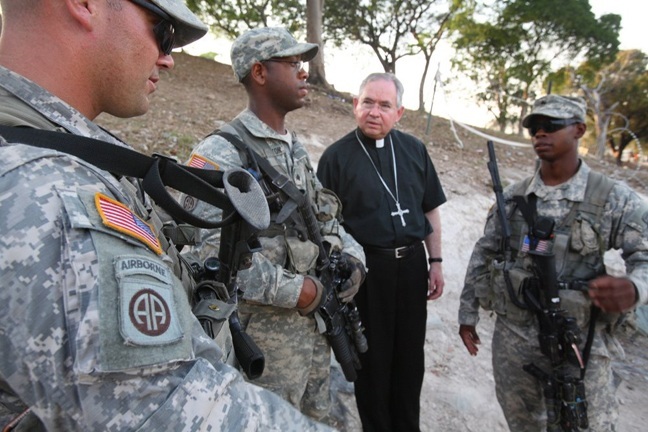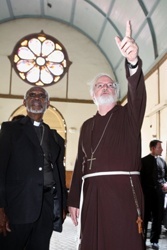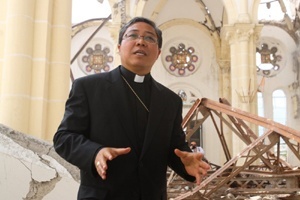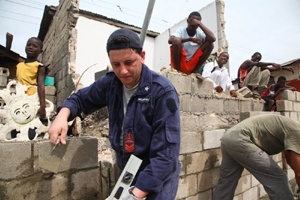By Tom Tracy - Florida Catholic
Photographer: TOM TRACY| PORT-AU-PRINCE, HAITI At the huge refugee camp at a former golf course at Petionville Club, San Antonio Archbishop Jose Gomez talks with members of the U.S. Armed Forces. The archbishop was part of a delegation from the U.S. bishops conference who visited Haiti in early March. Catholic Relief Services is helping run the tent city at the former golf course.
Photographer: TOM TRACY| PORT-AU-PRINCE, HAITI Cardinal Sean O'Malley of Boston tours the damaged archbishop's chapel near the ruins of the cathedral in Port-au-Prince, Haiti, during a visit by a delegation from the U.S. bishops' conference earlier this month. With him is the newly appointed archdiocesan administrator of Port-au-Prince, Auxiliary Bishop Joseph Lafontant. Photographer: TOM TRACY| PORT-AU-PRINCE, HAITI At the ruins of the Haiti cathedral, the papal nuncio, Archbishop Bernardito Auza, gives an explanation of the damages to a visiting delegation from the U.S. conference of bishops Photographer: TOM TRACY| PORT-AU-PRINCE, HAITI Members of the Italian Armed Forces help repair a security wall at a Salesian mission in Port-au-Prince. The government of Italy is funneling some of its aid to Haiti through the network of Salesian organizations.
Never having seen Port-au-Prince before the earthquake, I find myself agreeing with those who look around and compare the Haitian capital to a war zone that has just been carpet bombed. Streets are clogged with rubble that one assumes will not all easily be cleared away.
We are told the so-called �heroic phase� of following a catastrophe winds down after a few weeks as the search and rescue teams head home, but at the end of February, the U.S. bishops led a small delegation (including Boston�s Cardinal Sean O�Malley, San Antonio Archbishop Jose Gomez and others) to tour the damages and offer a message of solidarity.
And there were plenty of heroics on display.
Those of us documenting the church delegation met people like Deacon Patrick Moynihan, a former commodities trader from the Diocese of Providence, R.I., who showed the bishops his multi-faceted Haitian Project. It features a school for gifted students who are taking on leadership roles in the recovery, including serving as translators for visiting medical staff at St. Francis de Sales Hospital, the oldest hospital in Haiti which is now 80 percent in ruins.
Deacon Moynihan lives in a humble residence in Haiti with his wife and several terrific children. These days the deacon is dedicating about a quarter of his time to helping the Archdiocese of Port-au-Prince solve some of its most pressing problems, including where to relocate the seminary and the old hospital.
Speaking of medicine, there are doctors from far and wide who have left their families for one or two weeks to sleep in tents, sleeping bags and guest houses while working long hours in unfamiliar circumstances. They roll up their sleeves and treat a myriad of secondary trauma situations and chronic illnesses, some of which are out of their areas of expertise but which they nevertheless engage with a spirit of charity. 
Then there are the local clergy, now without their Archbishop Joseph Serge Miot, described as a kindly and spiritual man who would have been leading the church at this time and receiving the many delegations of visitors but instead lies in a temporary grave outside of town.
In his place, the newly appointed archdiocesan administrator, Auxiliary Bishop Joseph Lafontant, is in charge now of securing the Church's role during this critical time. Giving general assistance to the effort is the tireless and always cheerful papal nuncio, Archbishop Bernardito Auza, the Vatican�s diplomat to Haiti.
Then there are the 1.3 million homeless. What can one say: You drive through the city and see people living in makeshift tents and housing, some of which we would not deem fit for an animal.
I saw a man standing on the second floor of a distressed building with nothing but a sledge hammer, smashing the concrete into pieces so that it could be cleared for new construction.
In one tough neighborhood, street youths already are back at their studies at a vocation training program with the Salesian missionaries, who are teaching young men and women to sew garments, to repair air conditioners, to make furniture � and if the finished product isn�t good enough to sell at market, the students don't pass the course.
Helping the Salesians rebuild a collapsed security wall were members of the Italian armed forces. I met a radar specialist from southern Italy who was mixing cement and laying bricks with the help of the very neighbors who live on what will be the other side of that wall. He praised the Haitian people for their friendliness, and asked to have his photo e-mailed to him when possible.
At the airport before leaving Haiti I sat next to a priest for an hour or so; turns out he was Father Rob�s Charles, pastor of St. Clement Parish in Fort Lauderdale, whom I had interviewed by phone a month before. Father Charles was just wrapping up his fourth medical mission from Florida to his homeland.
The priest said he saw signs everywhere that the Haitian people are getting on with their lives, making steady progress in their situations and staying active.
The fact that visitors and relief workers can finally fly directly in and out of Haiti is one small miracle. There are many more going on every day in Haiti. I am certain no one will ever know them all.
Tom Tracy is a freelance writer living in West Palm Beach. He was formerly editor of the Palm Beach edition of the Florida Catholic and has worked as a stringer for Our Sunday Visitor and Catholic News Service.


Comments from readers
Writers and photographers, like Tom Tracy, are also among the many heroes that abound in Haiti.